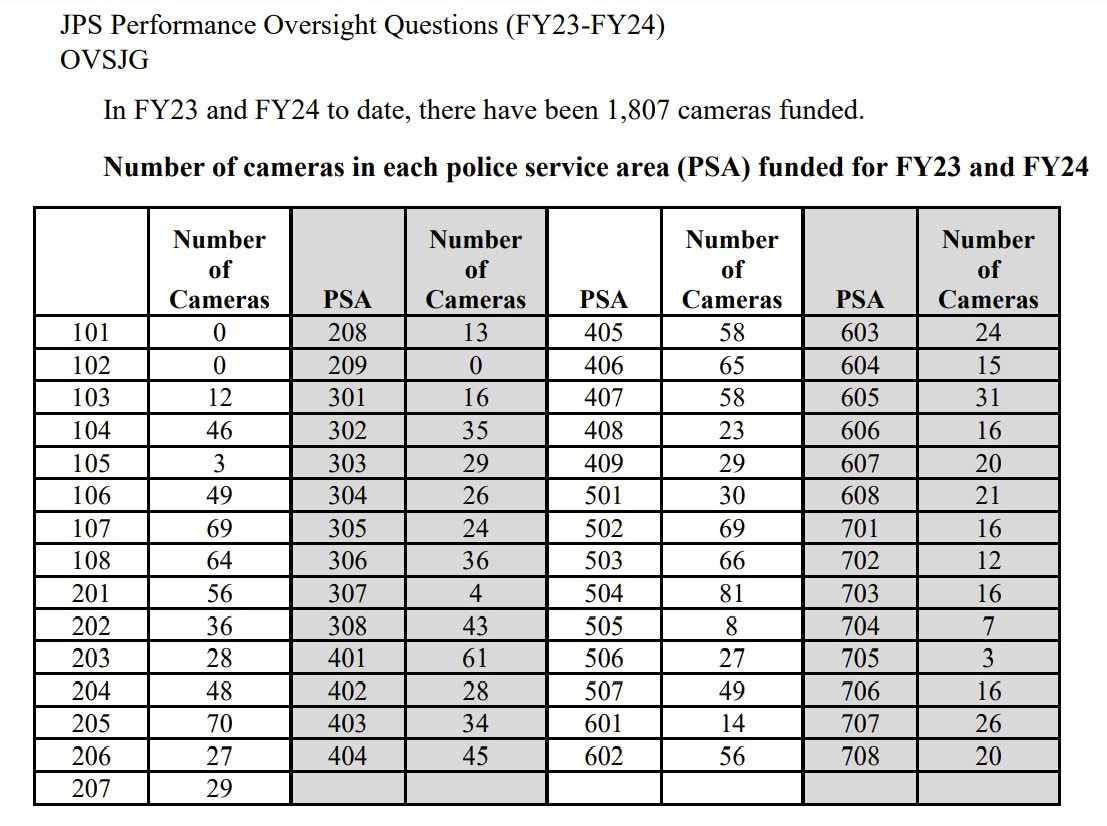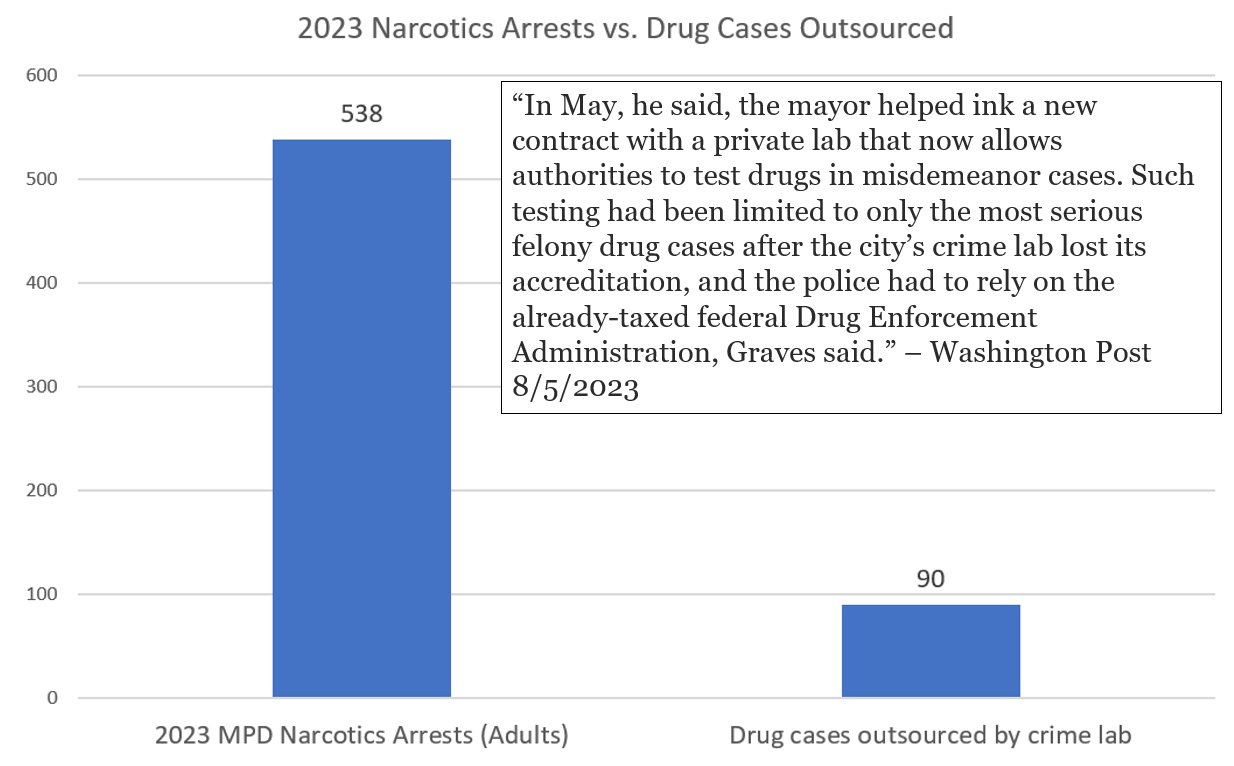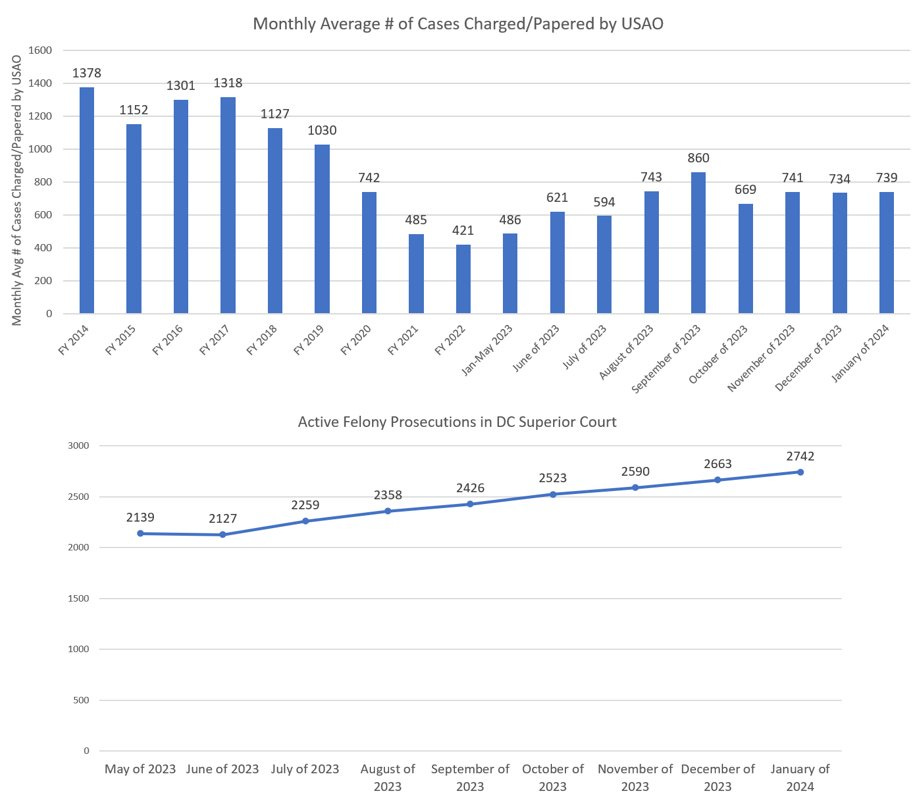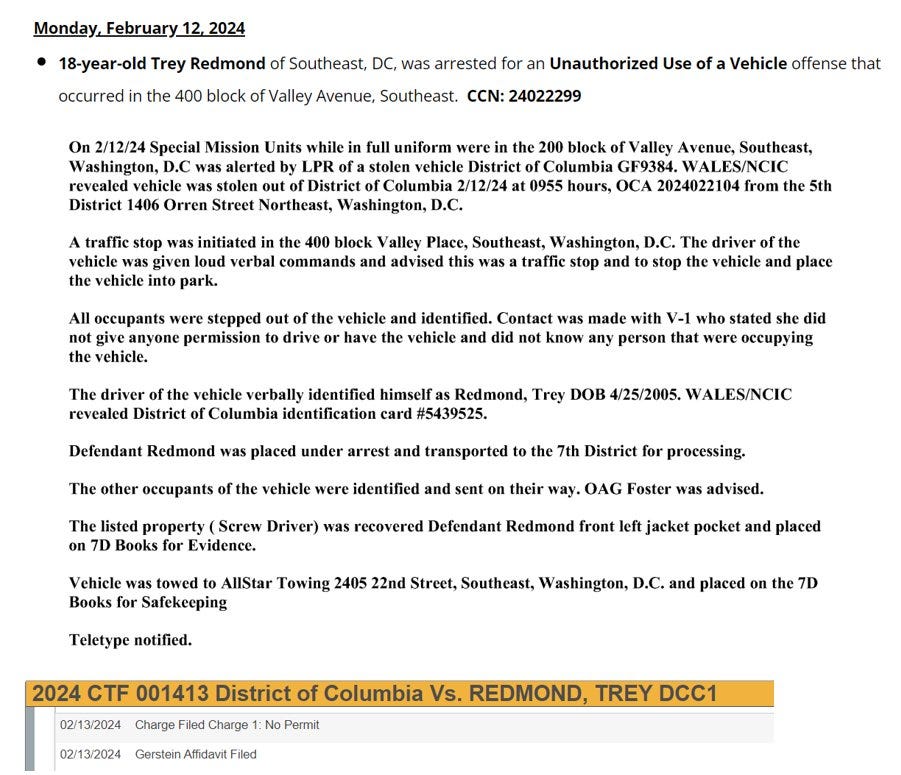Vacancies, backlogs and performance oversight
Highlights and lowlights from newly released data and testimony
The DC government is in the midst of “performance oversight;” an annual process where agencies (and interested members of the public) testify before the DC Council about agency operations. While there are hearings throughout the year, this period of time is a relative flood of information that gives the public answers and data that agencies often withhold. This post will be a selection of highlights from a few agencies that have testified so far; as well as the latest prosecution data from the United States Attorney’s Office (USAO).
As of publication, the agencies’ responses are attached to the page for their respective hearing like in this example under “Other Documents”:
Below we’ll go through some of the crime-related agencies under the Judiciary and Public Safety committee that have submitted their oversight responses. Note that two of the most important agencies, the Office of the Attorney General (OAG) and the Metropolitan Police Department (MPD) have not submitted their oversight responses yet and so will have to be covered in a future post.
DC Sentencing Commission:
Executive Director Linden' Fry’s testimony revealed that felony counts sentenced in 2023 were down 3.2% from 2022 and down 21% from 2019:
“In 2023, the Commission received and analyzed sentencing information for 1,473 felony counts, representing 1,046 felony cases and 1,007 individual defendants. Compared to 2022, these figures represent a 3.2% decrease in the total number of counts, a 13% decrease in the total number of cases, and a 12% decrease in the total number of defendants sentenced. These numbers are approaching but remain below pre-pandemic levels in 2019, which saw 1,865 individual counts sentenced (21% more than 2023).
This decrease in felony sentencing makes some sense given how long it takes for even a strong case to progress to a sentenced felony conviction. Since USAO new prosecutions were at record low levels in 2021 and 2022, it’s likely that lull contributed to the decreased volume of sentenced felony counts in 2023. One would expect the volume of sentenced felonies to increase the further we get from the rock bottom years of 2021 and 2022.
In 2023 DC judges once again overwhelmingly imposed sentences within the bounds of the voluntary sentencing guidelines:
“For the past ten years, judicial compliance with the Guidelines has consistently reached 91% or higher. Since 2018, the compliance rate has been at 97% or higher. The overall judicial compliance rate in 2023 was 98.6%, up slightly from the 97.3% compliance rate in 2022.”
This fact is important to remember when defendants receive a sentence that is considered “too light” by some members of the public. Very often the sentence is light because the actual convicted offense is a lesser one than they were charged with (usually due to a plea bargain) and/or the sentencing guidelines explicitly allow for the “light” sentence. But the scenario where a judge “goes rogue” and imposes a lighter sentence than is called for in the guidelines is actually quite rare and reinforces how important the guideline-making process is for justice in DC.
Lastly the DC Sentencing Commission notes that “Sharing data request responses has been a successful initiative” and this is absolutely true. Their data responses have been essential to a lot of the reporting on this Substack and it’s great news for DC that they intend to continue and expand their publicly-available analyses. Hopefully policymakers are vigilant about defending the Commission from any efforts at censorship by powerful “stakeholders” who dislike transparency into prosecutions and sentencing.
Office of Victim Services and Justice Grants (OVSJG):
This agency has a varied portfolio that includes DC’s truancy reduction program. Over 60% of DC high schoolers were chronically absent last school year and this correlates with a greater risk of kids getting into trouble and being arrested as reviewed in this post:
As has been true in past years, the Truancy Reduction program is only serving a fraction of the thousands of DC kids who are missing significant periods of school:
“Based on current projections and grantee capacity for FY24, we anticipate serving approximately 1,290 students across 25 schools this school year. As of November 27, 2023, there were 681 students engaged across our SUSO and High School program providers.”
The 1,290 students served projection compares to over 5,500 high schoolers that missed more than 30% of last school year. One reason that so few students are being supported by this program is that Mayor Bowser cut the Truancy Reduction program’s funding by 57% for FY 2024.
On a more positive note, some of OVSJG’s grantees did have some promising outcomes regarding recidivism reduction:
The “Changing Perceptions” program in partnership with Gallaudet University had a cohort of 30 “returning citizens” who had recently been released from prison and none of them were re-arrested. This program reported high (85%) participant engagement with mentorship and 90% of participants said it had helped improve their family relationships. It’s a small sample but an encouraging start.
“The Justice Policy Institute supports continued implementation, coordination, and analysis of the Incarceration Reduction Amendment Act of 2016 (IRAA) and Second Look Amendment Act of 2020 (SLAA). As of September 30, 2023, JPI determined that 182 individuals returned home under the IRAA/SLAA and related reforms. JPI also reported that as of the end of FY23, of the 182 releasees, only seven had been rearrested (a 3.8% recidivism rate).” It should be noted that having the “analysis” of these returnees be conducted by an entity that also supports the program does raise some appearance of bias but if true this is an incredibly low recidivism rate. This also reinforces the fact that the IRAA and SLAA were very small scale reforms with less than 30 offenders being released per year under these laws. These laws have had a fraction of the impact of the USAO decreasing its annual number of prosecutions from 15,810 in FY 2017 to just 5,054 in FY 2022 despite the legal changes facing far more media criticism prior to 2023.
OVSJG also oversees grants that support crime victims. One major area of focus is supporting survivors of domestic violence. In Fiscal Year (FY) 2023 “OVSJG awarded over $10 million in ARPA funds to domestic violence service providers for housing and services” and opened a 24/7 shelter that can provide “immediate placements for survivors and families within an hour of a domestic violence incident.”
Lastly OVSJG oversees DC’s security camera rebate program:
It appears that the program paid for 307 cameras in DC's wealthiest police district (2D) and just 116 in DC's poorest police district (7D). The Police Service Area (PSA) with the highest number of funded cameras (70) was PSA 205 in the Palisades/Spring Valley area which also has some of the lowest crime rates in DC. Rich areas benefitting more from this rebate has been a longstanding disparity in the program that’s been noted by the DC Auditor and there’s a provision in the Secure DC bill to make it easier for lower-income Washingtonians to benefit from this program. As a public service announcement, if you don’t have a camera you should consider installing one. It may help deter or solve a crime against you or your neighbors.
Department of Forensic Sciences (DFS):
DFS includes the crime lab whose reaccreditation and outsourcing troubles have made it harder to solve and prosecute crimes in DC. DFS’ oversight responses included their “Performance Accountability Report” for FY 2023 which is the first quantitative update on their operations in months (since the agency generally shares no timely performance metrics with the public). Notably their numbers for past fiscal years do not match their previous reports (which I used in this post) and the charts below are using the data in the FY 2023 report. Starting with evidence collection, the Crime Scene Sciences division processed almost twice as many evidence items in FY 2023 as the previous year and their response and processing times seem to have suffered as a result. According DFS’ data the number of “crime scenes processed” increased from 4,539 to 12,251 in FY 2023; an almost unbelievable 170% increase. The massive variation in evidence items and crime scenes accounted for in DFS data raises some questions about their record-keeping and/or implies significant problems in FY 2022.
Despite the massive increase in the volume of evidence items, there was relatively little increase in the number of latent fingerprint entries or matches/”hits” with existing fingerprint records. The number of entries (made by an outside vendor Ron Smith and Associates) increased a bit from FY 2022 but still remains far below the FY 2020 levels before the lab lost accreditation:
Notably the Latent Fingerprint Unit (LFU) is one of the units that is still not accredited and they don’t intend to re-submit for accreditation of this unit until December 2024: “DFS intends to expand the scope of accreditation to include the Latent Fingerprint Unit. The agency plans to have the expansion assessment coincide with the 2024 Surveillance Assessment in December 2024.”
DFS didn’t include the number of DNA (CODIS) entries made by their outsourcing partners so it shows up as a 0 in their report (though their vendors are making some small volume of entries):
The current CODIS backlog is massive at 1,176 profiles and DFS’ best case scenario (where the FBI helps the Forensic Biology Unit (FBU)) will still take 27 weeks to eliminate the backlog:
“As of January 2024, FBI has authorized the FBU to process CODIS hits and is currently reviewing the external assessment report to provide full authorization for CODIS entries and uploads. The FBU anticipates receiving this authorization in February 2024. The FBU currently has a CODIS backlog of 1,176 profiles. Once fully authorized by the FBI, FBU has developed a robust plan to efficiently eliminated the CODIS backlog within 27 weeks.”
Confusingly, in a separate part of their oversight responses they say the CODIS backlog will instead take 19 weeks:
”FBU will continue to reply on outsourcing until the backlog has been eliminated which is projected to occur in FY25. The CODIS backlog will take 19 weeks to eliminate.”
The FBU is one of the two units within the crime lab to regain accreditation and is mostly staffed; so they should be able to help process the backlog in addition to the ongoing outsourcing support. However the other re-accredited unit is the Forensic Chemistry Unit (FCU) is in worse shape and has only 3 of 9 staff positions filled:
The FCU is important for testing drug evidence. Recall that drug prosecutions collapsed in DC when the crime lab lost accreditation and this likely exacerbated DC’s gun violence problem given the well-documented nexus between DC’s drug trade and deadly shootings:
The FCU having a 67% vacancy rate is a bad sign for DC significantly ramping up drug prosecutions. It also raises the risk that any effort to enforce the much-discussed “Drug Free Zones” will just serve to increase the number of declined prosecutions. While the USAO and Mayor Bowser made a big deal about “a new contract with a private lab” to test drug evidence; it only handled 90 cases in FY 2023 (so from when they signed the contract in May through the end of September) for ~$44K and MPD officers still report than many drug cases are “no-papered” by the USAO for lack of evidence testing capacity. While any incremental progress is welcome, DC still needs more drug testing capacity to successfully prosecute the drug arrests that MPD is already making; plus any increase from the “Drug Free Zones” effort:
Office of Neighborhood Safety and Engagement (ONSE):
ONSE is very important because it houses a number of violence prevention, interruption and rehabilitation programs. One example is the “People of Promise” (PoP) program which is intended to intervene with the highest-risk people in DC and prevent them from ending up as a suspect or victim in a shooting. Unfortunately the program has had a rough implementation and currently "Of the 258 eligible participants, 66 (26%) are working with the PoP support team." This also reflects a significant attrition from 153 unique people served by the program down to just 66 currently engaged; i.e. only 43% of ever-served participants are still engaged:
One sign that People of Promise may be impacted by “mission creep” is that “PoP staff hosted three (3) back-to-school resource fairs serving approximately 150 families in ONSE priority communities.” There’s nothing wrong with helping families get ready for school but that is relatively disconnected from the program’s original hyper-focus on the 200-500 people (mostly young adult men) who are responsible for 60-70% of gun violence in DC. It seems unwise to be branching out to new tasks when so few of the highest-risk people are even engaged in the program.
The Pathways program aims to train and secure employment for at-risk individuals. Over the last year they reported these outcomes for their participants:
78% complete the training course
50% secure a subsidized job
24% secure an unsubsidized job
5%-26% of the program participants under CSOSA are re-arrested (depending on the cohort)
It’s obviously concerning that so few graduates are able to secure a regular (unsubsidized) job in what is still a strong labor market with a relatively low unemployment rate. While there are enormous disparities in DC’s unemployment rate, on an overall level it’s better than at any point from 2003-2022. So if we’d ever see DC employers warming up to hire people with criminal records and/or other challenges that put them “at risk” it would be now:
On the other hand, if the subsidized jobs are shown to be a good “protective factor” against recidivism it may be worthwhile to simply expand them so that any Pathways program graduate gets a job since the alternative (incarceration and the cost to any crime victims) is so much more expensive. Unfortunately I don’t believe we have any analysis on this program so it’s hard to assess its impact. If nothing else the Council should probe why so few program participants can even secure subsidized jobs as a first step into the legitimate labor market.
The Violence Intervention program remains very difficult to assess. It’s hard to tell how their reported “engagement” metrics compare to the need or if/how they influence outcomes:
”In FY23, 344 neighborhood mediations and ceasefires were conducted, and 471 ‘community touches’ – or engagements - were made across the District.”
”The VI program held 77 events and activities engaging hundreds of community members and clients, including a job interview seminar and weekly client group sessions.”
There are some violence interrupters who work themselves into the ground doing dangerous work to keep the peace between gangs/crews in DC’s most dangerous neighborhoods. One challenge is that it’s been incredibly difficult to determine what is working in this program and how to scale success in one neighborhood to others or hold failing grantees accountable. And we should remember that these violence interruption programs are stuck operating in an environment where the lack of arrests and prosecutions has undermined their work by reinforcing a sense of “impunity” among DC’s gang/crew members. One of the best ways to make these rehabilitative programs that offer metaphorical “carrots” more appealing to the target audience is to ensure that the enforcement “sticks” of arrest and prosecution make continued illegal behavior look like a bad bet.
However there continues to be no net progress in increasing adult prosecutions in DC over the last 4 months. The USAO released prosecution data for January and it shows a continued rate of ~740 new cases each month.
While the USAO’s new “plateau” is a higher volume than the <500 cases per month they brought in FY 2022 and January-May 2023 it is still down 14% from their September 2023 spike that conveniently was the end of the FY 2023 reporting period.
Note the January data primarily reflects operations before the DOJ announced additional prosecutors to address violent crime in DC (which happened on January 26th)
Since prosecution volumes have been stable it’s likely that the prosecution rate is still close to the 53% reported by the USAO for last quarter of FY 2023. The actual % could be higher or lower by a few percent depending on if MPD arrests have increased or decreased.
Zooming out, the current volume of prosecutions is still far below the USAO’s average volume during the years FY 2014-2017; before the huge decrease in prosecution rates.
Notably the caseload of “active felony prosecutions” is up 29% from June 2023. This suggests that the courts are not keeping up with even this modest increase in prosecutions. This may be weighing on internal USAO decisions and if this growing caseload is seen as a burden it could be nudging prosecutors towards declining new cases, dropping existing cases or offering more generous plea bargains to close out existing cases. While the USAO would be extremely unlikely to admit that workload considerations have any role in prosecutor decisions, it’s definitely possible. It’s human nature for workload to influence one’s decisions so it would take an unnatural degree of discipline by prosecutors (and/or more resources) for a 29% increase to not have some impact.
This 29% increase in the felony caseload also corresponds with a 33% increase in the DC jail population over the same timeframe. This strongly suggests that the increase in USAO prosecutions is the primary driver of the increase in the DC jail census and that the pretrial detention aspects of the Summer crime bill had a very small impact. This appears to be another vindication that how laws are enforced has a much larger impact on the ground than the legislative tinkering that continues to dominate media coverage of crime policy.
Contrast the flat trend in actual prosecution volumes with the optimistic spin from the USAO when they presented the FY 2023 data (i.e. through September, before the recent drop in prosecutions):
“In the last three months of the fiscal year that ended Sept. 30, Graves said, his office prosecuted 53 percent of arrests, and he said he believes that prosecutions will continue to rise in the current fiscal year.”
That obviously did not happen. While the vast majority of the USAO’s prosecutions for local DC crime happen in DC Superior Court (and the data above reflects those cases) they also file a small number of cases in District Court. Thanks to an assist from Crime Data DC we can see that there hasn’t been an increase in District Court cases either:
In 2017-2019 the USAO created ~201 cases per month
There was a huge spike associated with the January 6th prosecutions
In 2022-2023 they created 136 cases/month (down 32% from the 2017-2019 average)
There’s reason to expect that the influx of additional prosecutors, analysts and other law enforcement resources to DC will increase prosecution volumes in subsequent months. But the January data helps confirm that absent that extraordinary high-level intervention the USAO was on pace for another year of business as usual, with 1/3 of FY 2024 already complete. And even now there are still batches of arrests that MPD announces where the USAO has very low prosecution rates. For example:
MPD announced 20 arrests for Unauthorized Use of a Vehicle (UUV)
15 of the suspects were adults & 5 were juveniles
Of the adults, 10 (67%) had no charges filed in DC Superior Court, 3 (20%) had lesser charges & only 2 (13%) had UUV charges
One of the cases appears to be incredibly strong (suspect is found in the car, the owner confirms she didn’t know the suspect or give him permission to use the car) and yet the only charges filed were a minor traffic offense (‘no permit”):
With motor vehicle theft still a serious problem in DC (though down from last year’s unprecedent “Kia Challenge” fueled levels) it’s extremely concerning that MPD is making so many arrests for driving/using stolen cars that don’t result in any prosecution. Chief Smith noted that “motor vehicle theft – which have helped to fuel violent crime” so it’s important that there are consequences for those stealing cars or using ones that are passed along by car thieves. We still have work to do to fix DC’s broken prosecution status quo.
For readers interested in prosecution the DC Attorney General’s performance oversight hearing is on February 28th (link here). While unfortunately the unelected USAO is beyond the scope of direct DC government oversight, the OAG plays an incredibly important role by overseeing juvenile prosecutions as well as some traffic and other offenses. These performance oversight hearings are one of the main ways that the public gets (some) real transparency into District government agencies and this post is just a small sample of the issues covered in these hearings. If you’re the kind of reader who wants to dig deeper into how these agencies operate I really encourage you to check the oversight responses and hearing recordings/transcripts. As always, thank you for reading and sharing this Substack with your friends and neighbors in DC.



















Thanks for the roundup!
A few notes on DYRS:
1. They continue to decrease their performance goals on training.
2. They say they have a 3.2% rearrest rate but the target is 25%.
3. The length of time kids await placement is really high and PDS testified to how bad it’s gotten.
4. Girls are sleeping in classrooms. Probably all the girls at YSC could be moved out to either New Beginnings or shelter homes. Or the community!
5. Most MOUs and contracts have not been renewed, including educational and programmatic support contracts.
https://www.courtlistener.com/audio/90690/andrew-hanson-v-dc/?filed_after=&filed_before=&entry_gte=&entry_lte=&order_by=desc